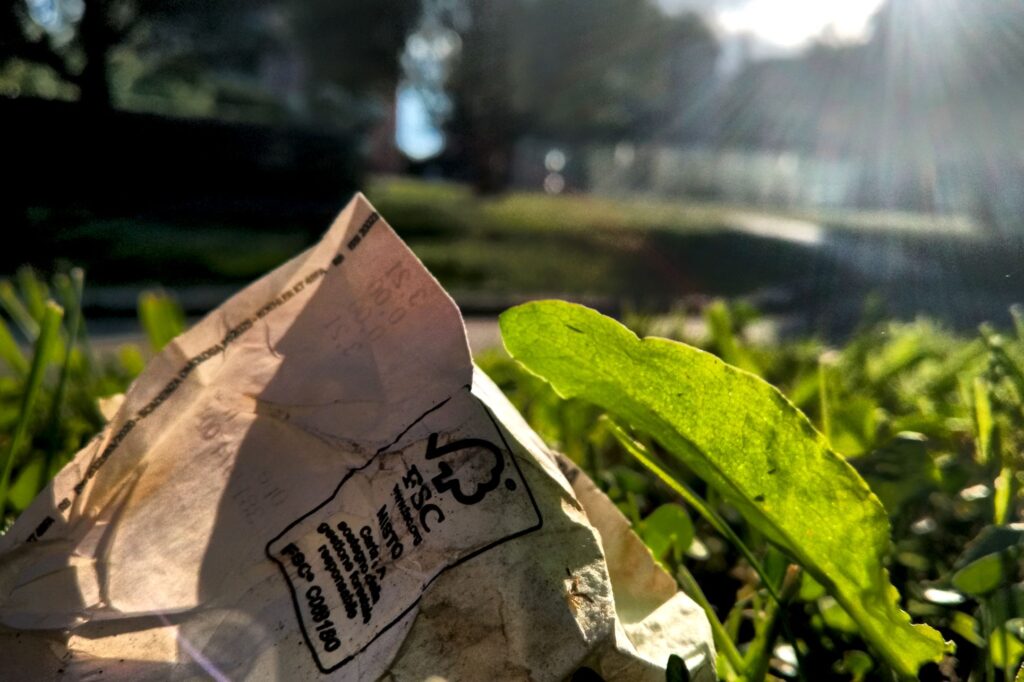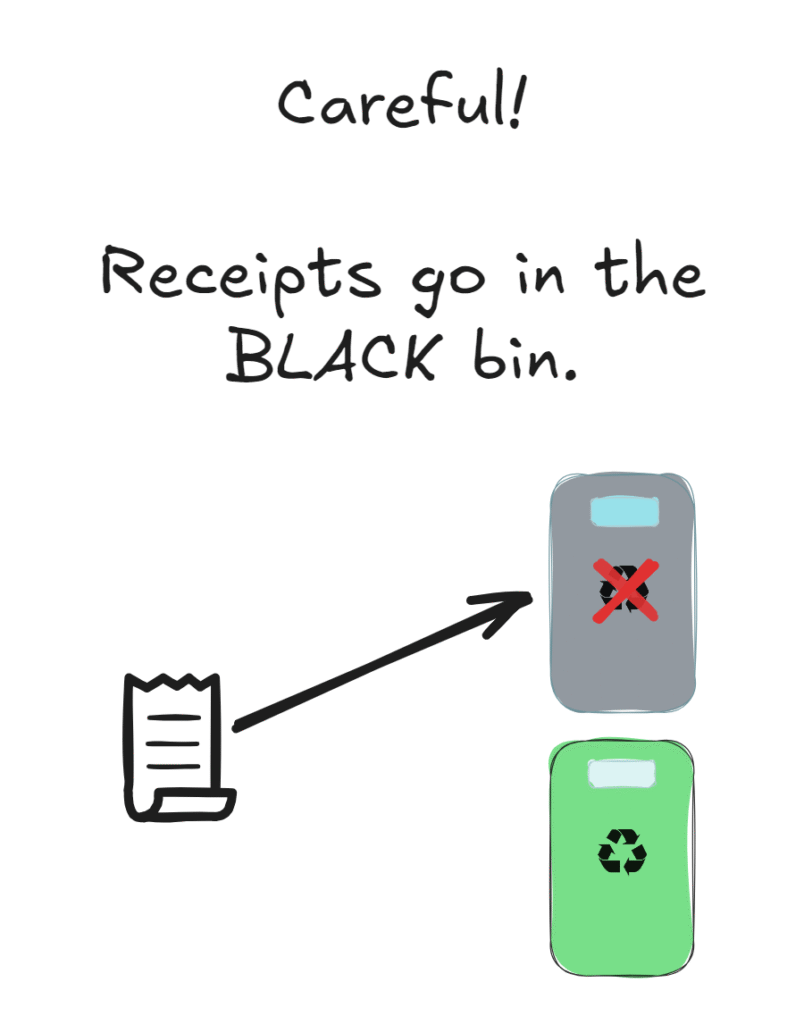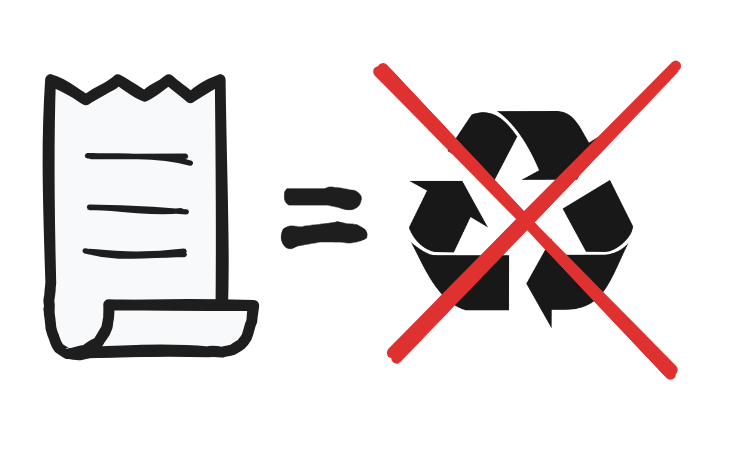Have you ever thought about what happens to a receipt after you throw it away? Maybe, like I did until recently, you’ve always tossed it in the paper recycling bin, sure that was the right place. Well, guess what? We’ve been doing it wrong!
Receipts actually belong in the regular trash because they’re not recyclable. I just found this out and I have to admit, it surprised me: shouldn’t they be made of paper and therefore easy to recycle?
Question
How many times do you get a receipt when you buy something? How many do you throw away in a week?
What’s the problem?
Receipts can’t be recycled because they’re not made of regular paper. They’re made of something called thermal paper, a special material that doesn’t need ink for printing. The paper itself changes color when it gets heated up!
It’s a clever idea to make things simpler and save resources, but not so great for our planet.

The “magic” behind thermal paper hides in a bunch of chemicals. To work, the paper is coated with special pigments called leuco dyes, which start out invisible but become visible (usually black) when heated in an acidic environment. To kick off this reaction, acidic substances like Bisphenol A (BPA) are needed. And that’s where the trouble lies: all this chemistry makes receipts non-recyclable, because these substances are tough to get rid of.
DEEPER DIVE
Why do leuco dyes change color?
Leuco dyes are complex molecules that, under normal conditions, are transparent. When heated, an acid in the thermal paper transfers an H+ ion to the molecule, changing its chemical structure. This change messes with the distribution of electrons in the molecule (specifically its conjugated systems), affecting how it interacts with light. The result? The pigment absorbs different wavelengths and appears colored (often black) to our eyes.

Is it just about recycling?
Nope, the problem is bigger than that. BPA, a common chemical in thermal paper, has been linked to all sorts of health risks, including cancer, infertility, diabetes, and obesity. That’s why the European Union banned BPA in receipts starting in 2020. But here’s the catch: in many cases it’s been replaced by Bisphenol S (BPS), a similar substance that might be just as bad. So basically, we’re still far from a safe and eco-friendly solution…
And what if you throw away receipts with paper recycling? The toxic stuff in receipts can contaminate recycled paper, which then gets used for things like food packaging. That’s a pretty risky situation, both for the environment and our health.

Are there better options out there?
Yes, there are types of thermal paper that are less toxic or even recyclable. Some stores are starting to use them, but the problem — as you might guess — is the cost. These materials cost a lot more than traditional thermal paper, so the switch hasn’t really caught on yet.
One alternative is digital receipts, but they come with their own issues: they need tech infrastructure, often use more energy, and can raise privacy concerns since your personal data gets collected and stored.
According to some estimates, billions of receipts are printed worldwide each year, with a huge environmental and economic cost. Just thinking about that quantity helps us realize how much difference a more sustainable system could make.
Question
How many receipts do you think are printed every day in your country? Think about every purchase, every coffee at a café, every parking ticket…
Challenge
If each receipt costs 1 cent and recyclable paper costs twice as much, how much would it cost your country to switch to a more eco-friendly solution?
What can you do about it?
Even if changing the whole system seems tough, there are small things that can make a difference:
- Skip receipts you don’t need. Some stores ask if you want one printed: just say no, if you can.
- Throw receipts in the regular trash. Don’t use the wrong bin: it matters!
- Talk about this problem. Lots of people don’t know that receipts can’t be recycled. Share what you know and help others make smarter choices.

Thermal paper is a perfect example of how a cheap technological solution can have hidden costs for our environment and health: behind something as simple as a receipt lie impacts we really can’t afford to ignore.
Educational Activities
Hands-on Experiments
- Try heating up a receipt gently with a hairdryer or by holding it near a lightbulb (always with an adult around!). Watch it turn black—why does this happen? Is it a physical or a chemical change? What if you do the same thing with regular paper? What’s different?
- Keep every receipt you get for a week. How many do you collect? Where do they come from? Are there places where you get a receipt even when you don’t really need one?
Math Challenges
- If everyone in your country gets about two receipts a day, how many receipts does that add up to in a year? If each one weighs about half a gram, what’s the total weight?
- A small shop uses about three rolls of thermal paper a week. If eco-friendly paper costs double (2 euros instead of 1 euro), how much more would they spend in a year if they switched to the greener option?
- What about a big supermarket? Some use 30 rolls a day. How much extra would they spend in a year if they changed to eco-friendly paper? (Remember: 30 rolls a day for 365 days!)
- Estimate how many shops and supermarkets are in your town or city. If they all switched to recycled paper, would the extra cost be worth it for the environmental and health benefits?
Discussion Starters
- What other solutions can you think of to reduce receipt waste?
- Is a digital receipt always more sustainable than a paper one? What problems or benefits might each have?
- Can you think of other everyday objects that seem harmless but hide surprising environmental problems?
Creative Ideas
- Come up with a catchy slogan or design a poster to spread the word about proper receipt disposal.
- Invent the “receipt of the future”: What would it need to be 100% eco-friendly?
Resources
- Thermal Paper — Wikipedia — A detailed article about thermal paper, including its chemical makeup, how it works, and its limitations.
- Receipt Makeover: Using Recyclable Paper — An in-depth look at greener alternatives to traditional thermal paper and the scientific challenges they present.
- Eliminating BPA from Thermal Paper (IT)— An article explaining how and why Bisphenol A was removed from receipts in Europe.

